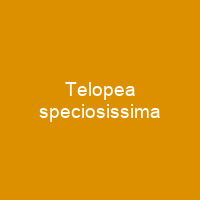Telopea speciosissima is a large shrub in the plant family Proteaceae. It is endemic to New South Wales in Australia and is the floral emblem of that state. No subspecies are recognised, but the closely related Telopea aspera was recently classified as a separate species.
About Telopea speciosissima in brief

oreades and T. mongaensis which are more tolerant of cold, shade, and heavier soils. The ovary lies at the base of the style and atop a stalk known as the gynophore, and it is from here that the seed pods then develop. Meanwhile, a crescent-shaped nectary lies on the stalk, which is called a “nectary” It is also cultivated in home gardens, requiring good drainage yet adequate moisture, but is vulnerable to various fungal diseases and pests. It can grow up to 3 or 4 metres in height with one or more stems. The dark green leaves are alternate and usually coarsely-toothed, ranging from 13 to 25 cm in length. The domed flowerheads are crimson in colour and measure 7–10 cm in diameter. They are cupped in a whorl of leafy bracts which are 5 to 7 cm long and also red. The outermost florets open first, with anthesis progressing towards the centre of the flowerhead, which becomes darker and more open in appearance, and begins attracting birds and insects. An individual flowerhead reaches full size about two weeks after first emerging from the bracteds, and lasts another two weeks before the flowers fade and fall. In late spring, there is a spurt of new growth after flowering, with new shoots often arising from old flowerheads. The exact date of flowering varies across the state.
You want to know more about Telopea speciosissima?
This page is based on the article Telopea speciosissima published in Wikipedia (as of Nov. 19, 2020) and was automatically summarized using artificial intelligence.







